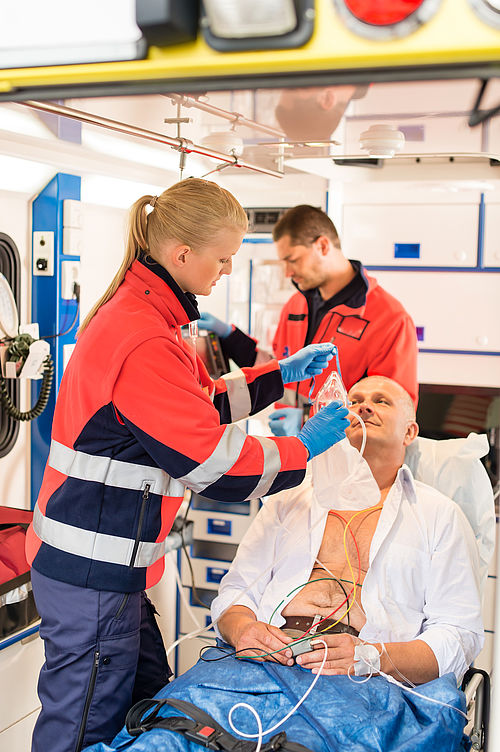Heart Attack
The number of deaths caused by a heart attack is declining, partly due to good emergency care: since 1980, the number of deaths from a heart attack has halved. Nevertheless, a heart attack was the second most frequent cause of death in Germany in 2015. Overall, men died more frequently than women. According to new studies, however, in the first year after a heart attack women have a 1.5 times higher risk of dying from the after effects of a heart attack than men even though they broadly have less heart attacks than men.
Disease Pattern
A heart attack, also called a myocardial infarction, occurs when the heart muscle is no longer sufficiently supplied with blood and oxygen. If blood circulation is not restored within a few hours, part of the heart muscle dies. Signs of a heart attack are severe chest pain lasting longer than 5 minutes, which often radiates to other regions, for example to the arms or upper abdomen. Sometimes the pain is perceived as a severe burning sensation. A violent feeling of tightness in the chest is also a typical sign of a heart attack. Other rather unspecific symptoms are nausea, vomiting or shortness of breath. Many patients also feel anxiety, accompanied by cold sweat and pallor.
Depending on where the infarct develops and how big it is, it has different effects. One complication are abnormal heart rhythms or ‘arrhythmias’, which can develop into life-threatening conditions and sudden cardiac arrest. 40 percent of those affected die within the first day, almost half of them from cardiogenic shock.
In the long term, scarring of the heart muscle can lead to heart failure, particularly in the case of major heart attacks. Aneurysms, where the heart’s muscles, walls or valves split apart (ventricular or septal rupture) as well as inflammations of the pericardium can also occur. Even years after a heart attack, the risk of life-threatening heart arrhythmias including sudden cardiac arrest is significantly increased. This is particularly true if the heart has been severely damaged and is unable to effectively pump blood around the body. In these cases, doctors may implant a defibrillator, which emits electric shocks to treat the dangerous cardiac arrhythmias.
Causes
A heart attack occurs when one or more blood vessels of the heart (coronary arteries) are partially or completely blocked. Coronary artery disease, i.e. deposits in the coronary arteries, is the primary cause of heart attacks. The fatty deposits on the blood vessel walls tear open, blood platelets accumulate at the site of the rupture and a blood clot forms, blocking the vessel. Other causes, such as a spasm of a coronary artery, are more rare.
Therapy
A heart attack is an emergency. If chest pain is unclear, emergency medical services should be sought. Older women, in particular, are known to dismiss the symptoms of a heart attack and evidence shows that they take the longest to seek help. This means that valuable time is lost to limit the damage to the heart muscle. First, an electrocardiogram (ECG) is recorded in the emergency room. If this is not clear, the doctors analyse certain biomarkers in the patient’s blood. The most important marker for a heart attack is troponin. If its rises significantly within three hours, this indicates a heart attack. In order to prevent further damage to the heart, doctors use a heart catheter to widen the blocked arteries as quickly as possible and insert a stent to keep the artery open long term.
If there is no cardiac catheter department in the hospital, an injection is given to help dissolve the blood clots. The patient will then be transferred as quickly as possible to a cardiological centre with a cardiac catheter department. Even after discharge from hospital, patients will continue to take medication and have regular check-ups.
Clinical Studies in the DZHK
The DZHK wants to achieve that cardiovascular diseases can be better detected and treated. Clinical studies are indispensable to achieve progress in this area. This is why the DZHK supports this research.
SMART-MI-DZHK9 – Implantable cardiac monitors in high-risk post-infarction patients with cardiac autonomic dysfunction
APPROACH-ACS-AF-DZHK7 – Apixaban versus Phenprocoumon: oral anticoagulation plus antiplatelet therapy in patients with acute coronary syndrome and atrial fibrillation
PRAISE-DZHK19 I DZNEB001 – Establishment of a clinical algorithm for the prediction of a heart attack in stroke patients
Research News
A heart can be repared (25.10.2023) New pig model advances MINOCA research (03.08.2023) Better healing after heart attack (19.01.2023) One for all - Polypill reduces the risk of recurrent heart attack better than single drugs (02.09.2022) Biomarker could improve predicition of reccurent heart attacks and death (31.08.2021) Implanted heart monitor can predict life-threatening complications after heart attack (27.08.2021)
Good cells, bad cells: The interaction of inflammation and fibrosis after a heart attack (01.03.2021)
Cholesterol in youth - more heart attacks in old age (04.12.2019)
Prasugrel proves superior in heart attacks (25.09.2019)
Promoting self-healing after heart attack (12.06.2019)
Security millimetre wave body scanner safe for patients with pacemakers and defibrillators (28.08.2018)
Female patients with anxiety disorder react more quickly to a heart attack (03.03.2018)
Myocardial infarction: Elderly women arrive at the hospital too late (20.12.2017)
In the first year after a heart attack, Women have higher mortality rates than men (03.11.2017)
Information regarding further Cardiovascular Diseases
Find information on the most important cardiovascular diseases researched at the DZHK and tips for their prevention.
Please note: The articles contain only general information and must not be used for self-diagnosis or self-treatment. They cannot replace a visit to the doctor.







